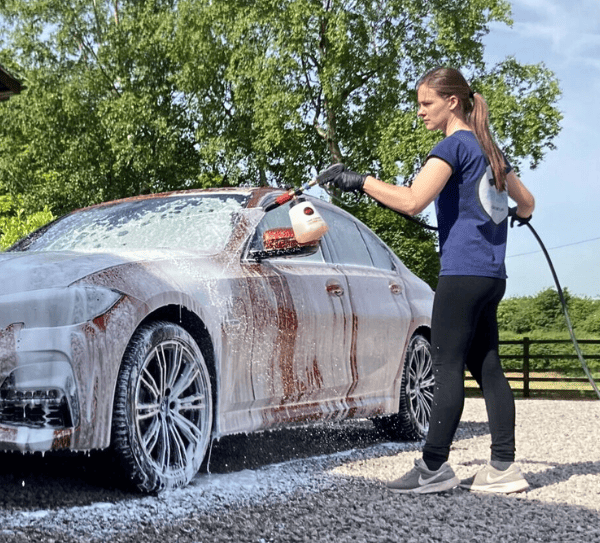Snow foaming your car not only looks cool, but it’s super important if you want to wash your car safely and dramatically reduce the risk of causing scratches and swirl marks. But there are a few rules and tips you need to know.
In this article, I’ll be explaining everything you could ever need to know about snow foam and how to use it so you get the best results. So let’s get started.
What is Snow Foam?
Snow foam is used to pre-wash the car before to remove as much dirt and grime as possible and minimise the risk of inflicting scratches when using the mitt afterwards. Snow foam is applied to the car using a pressure washer, left to dwell for a few minutes and then rinsed thoroughly.
Intro to Snow Foam
Dirt is abrasive to your car’s clear coat, and whenever it’s dragged along the surface it has the potential to cause scratches and swirl marks. So in order to reduce this friction, you can pre-wash the car using a snow foam.
Snow foams lift as much of this dirt away as possible before you actually touch the paintwork using your wash mitt (contact washing). So, when you perform the contact wash, there’s less risk of dragging dirt along the paint and inflicting clear coat damage.
The thickness of the foam and the amount of dirt the snow foam removes is highly dependent on the product you’re using. Later in the article, I’ll be talking about my favourite snow foam and why it’s so effective.
What You’ll Need to Snow Foam a Car
To properly snow foam your car you’ll need the following equipment:
- Snow foam cannon or lance
- Snow foam
- Pressure washer
If you don’t have a pressure washer, it is still possible to snow foam your car, but you will need a cannon that attaches directly to the hose. If you don’t use a pressure washer that foam will definitely not be as thick.
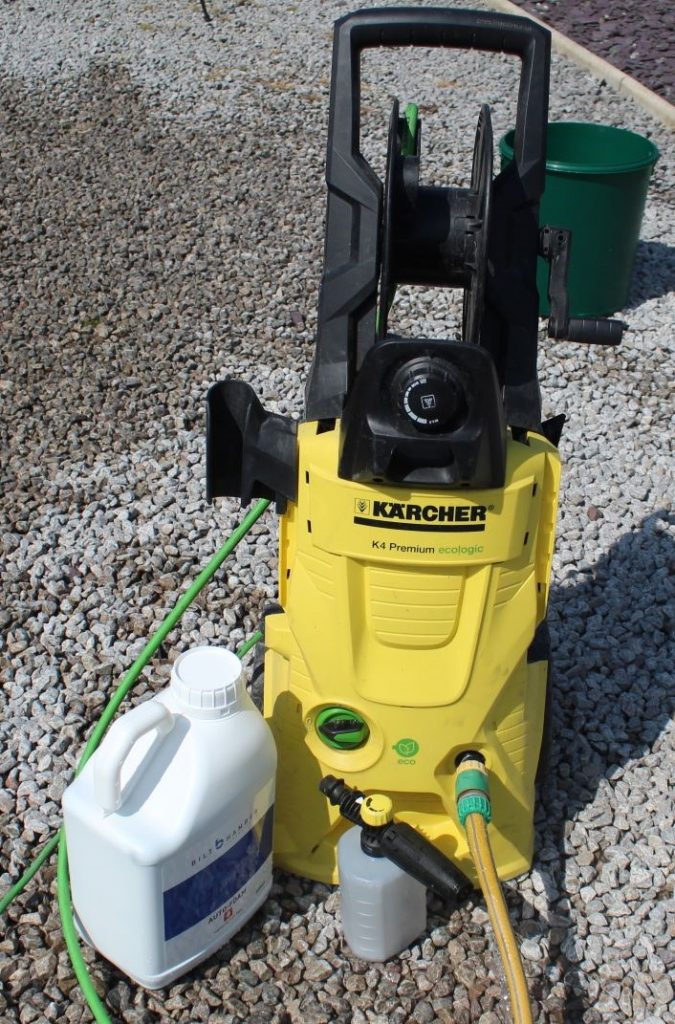
Alternatively you can use a foaming pump sprayer to apply the snow foam but this will be more time consuming. However, if you have a high quality pump spray bottle, the foam can actually be quite thick.
How to Use Snow Foam
Here’s how to use your snow foam on your car.
- Fill your snow foam cannon with the ratio of snow foam and water as specified by the manufacturer (usually between a 19:1 to 4:1 ratio of water to foam).
- Attach the cannon to the pressure washer lance and turn the pressure washer on.
- Coat the car from top to bottom with snow foam.
- Let the snow foam dwell for the specified contact time (usually 4-10 minutes) but do not let it dry.
- Thoroughly rinse the snow foam away with a pressure washer.
Do You Need to Wash Afterwards?
You should always wash a car after snow foaming in order to remove the remaining dirt and traffic film. Snow foaming does not remove all the dirt on the car so the car should be washed using a microfiber or lambs wool wash mitt and car shampoo afterwards.
Snow Foaming Variables
There are several variables in the snow foaming process to consider that will affect the results, both in terms of how thick the foam is, and also the cleaning power it has. Here’s what you need to consider.
- The type of snow foam
- Snow foam concentration (ratio to water)
- Dwell time
- Cannon type
Now let’s take a look at these in a bit more detail.
Types of Snow Foam
There are of course hundreds, if not thousands of different brands that make snow foams and they’re all slightly different. But these can be boiled down and split into two main categories.
There are two main types of snow foam: alkaline and pH neutral. Alkaline snow foams have higher cleaning power, but can have some wax-stripping effects. Whereas pH neutral snow foams are more gentle.
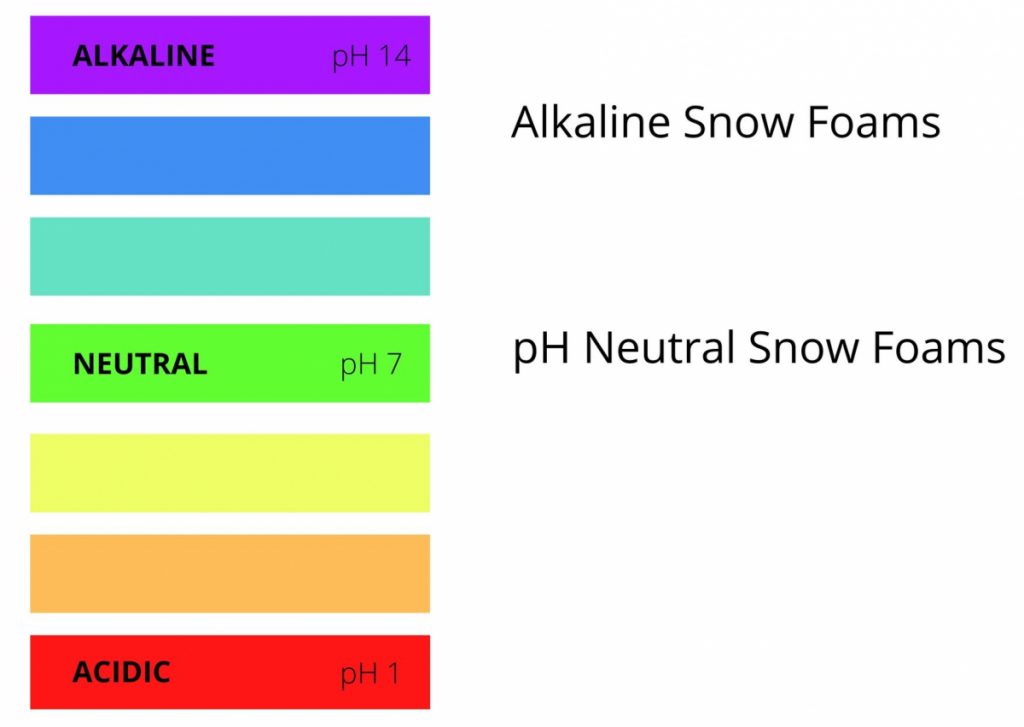
Alkaline snow foams are best for when the car is dirtier, and pH neutral snow foams are more suitable for lightly dirty cars because they preserve waxes and sealants more.
Personally, I use an alkaline snow foam because I am more concerned with the foam having good cleaning power than being completely wax-safe. I would rather remove as much dirt as possible to help reduce the risk of swirls and scratches during the contact wash, and have to apply a wax slightly more often.
Alkaline and pH neutral snow foams are similar in terms of thickness. This really depends on the brand of snow foam you’re using, the concentration and the cannon type instead.
What about coloured snow foams?
Some snow foams are formulated to produce different coloured foams, usually pink. There is no real advantage of using a coloured snow foam except if you prefer the look. You should also be careful not to let it dry on either your car or your driveway as it can cause staining.
Dwell Time
The amount of time you let the snow foam sit on the car before rinsing is known as the dwell time. This affects the cleaning power of the snow foam, hence, how much dirt is left on the car after rinsing.
Longer dwell time = more time to clean but higher risk of drying
It’s really a balance. You want to leave the snow foam so it has enough time to work, but not too long so that it dries (potentially causing soap stains).
You should always follow the instructions as specified by the manufacturer because all snow foams require a different dwell time and they can vary quite significantly.
The specified contact time will usually be given as a range. For example, a lot of snow foams recommend a dwell time of between 4-10 minutes. The hotter the weather, the shorter the dwell time should be.
You should never let snow foam dry on the car, so rinse the car after a shorter amount of time if necessary and do not use snow foams in direct sunlight or when the panels are hot.
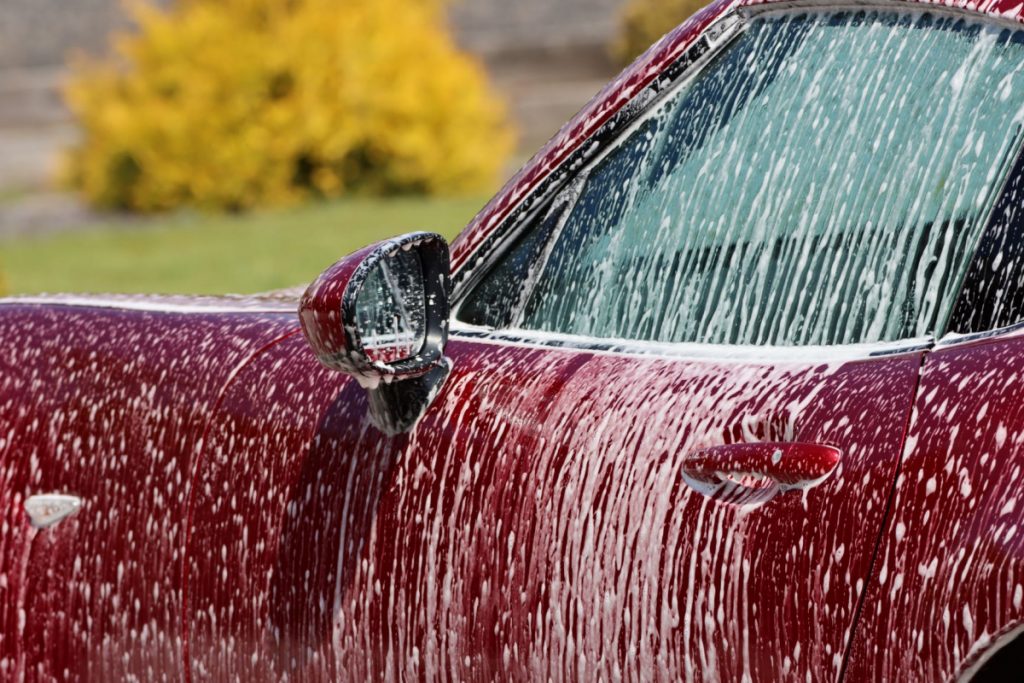
Snow Foam Concentration
It’s important to use the correct concentration of snow foam in the cannon to get the most out of the pre-wash process, without wasting foam.
Pretty much every snow foam needs diluting in water in the cannon. A lot of manufacturers will give you the ratio to water that you should put in your cannon. But others make it a little more complicated.
Some manufacturers will specify the panel impact ratio that should be applied to the car. This is where things get a bit confusing.
The panel impact ratio is often given as a percentage (usually between 1-5%). This does not refer to the amount of snow foam you put in the cannon, but the amount of snow foam that actually hits the car as it passes through the cannon.
To calculate the amount of snow foam you need to put into the cannon, you need to work out the output of the cannon first.
Luckily it is quite easy to do. I’ve created this very short video on the Auto Care HQ YouTube channel to demonstrate how to work out the panel impact ratio (PIR). This is also sometimes called the final dilution ratio (FDR).
If you don’t want to watch the video explaiation, here are the basics.
Calculating the Panel Impact Ratio of a Snow Foam
- Fill your snow foam cannon with water.
- Dispense the cannon filled with water into a bucket.
- Measure how much water was dispensed.
- Calculate the desired PIR by calculating the percentage of how much water was dispensed in step 3.
If you’re struggling to work this out, then here’s a link to a Google Sheets calculator I’ve made so you can plug in the numbers and the formulas will work out how much water and snow foam you need to add to your cannon.
It works for both mL and oz, just make sure you use the same unit throughout.
PIR Calculator on Google Sheets
Cannon Type
There are also several types of snow foam cannons (also known as foam lances). Here’s how they all differ:
- Materials: some have brass/ metal fittings which are more durable than plastic fittings.
- Adjust-ability: some cannons allow you to control the foam’s thickness and spray pattern.
- Compatibility: different cannons have different fittings which can be changed for use on different pressure washers.
- Shape: some bottles have an even diameter and others are wider at the bottom to make them less likely to topple over.
- Price: cheap snow foam cannons start at around $15 and can go up to more than $100.
Pre-Rinse First?
There is a bit of a debate in the detailing world as to whether or not you should rinse a car before snow foaming, or only afterwards. Here’s my take on it.
It’s important to snow foam a car after rinsing it first with a pressure washer in two situations:
- If the car has a lot of caked on dirt or mud that can be easily rinsed away with a pressure washer to make sure the snow foam has a thinner layer of grime to lift.
- If it is a warm day then it is good to rinse first because it cools down the panels and stops the snow foam drying out as quickly.
Otherwise, you can just apply the snow foam to a dry vehicle. This allows it to work more effectively because it is not being diluted by the water that’s already sitting on the panels.
Getting Thicker Foam
Everyone wants thicker snow foam. There’s no denying that it looks cool, even if it makes the neighbours think you look a little crazy. But sometimes this super thick foam can be difficult to achieve.
The thickness of the snow foam mainly depends on the cannon you’re using, and the snow foam formulation. More expensive cannons tend to produce thicker foam. And some snow foam products are just foamier and thicker than others.
If you want the easiest way to get thicker foam, then upgrade to a PA foam cannon, and use a higher concentration of snow foam.
Looking for thicker snow foam? Check out my 8 top tips for getting thicker and better quality snow foam.
Remember though, that the thickness of the snow foam isn’t everything. I’d much rather have a thinner snow foam that has great cleaning power and removes plenty of dirt, rather than a super thick layer of foam that doesn’t have any cleaning power.
Sure, it looks cool, but it’s not actually the thickness of the foam that makes the wash process safer, but the ability to remove traffic film and dirt. So don’t get caught up on this illusion that thicker foam = a better pre-wash.
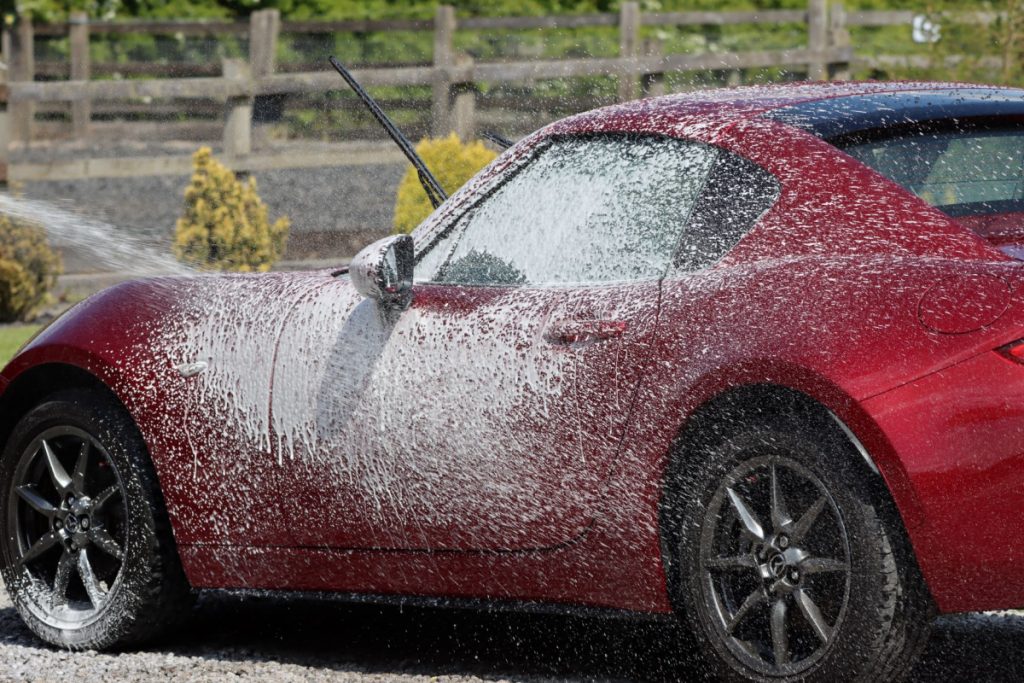
Snow Foam Without a Pressure Washer
If you don’t have a pressure washer, then it can be difficult to snow foam your car effectively, but there are still a few things you can actually try.
- Use a snow foam cannon that attaches directly to your garden hose.
- Use a foam pump sprayer to coat the car manually.
These are both pretty good methods, but it can be difficult to get thick snow foam when using a garden hose as the pressure is much weaker than with a jet washer.
Using a foam pump sprayer is a good option to get thicker foam without using a pressure washer, however it can be time consuming to coat the entire car manually, and it will require more snow foam product.
Drawbacks of Snow Foam
So snow foam is pretty great. It makes the wash process much safer by removing a lot of the dirt before the contact wash so you really minimise the risk of inflicting clear coat damage. But there are a few drawbacks and limitations of snow foaming that you should be aware of.
You Still Need to Wash the Car
It’s very difficult to do a completely contactless wash of a car and get it completely clean. Although snow foam does remove the vast majority of traffic film (if you purchase a snow foam with high cleaning power), however it doesn’t remove everything and you will still need to wash the car with a wash mitt afterwards.
If you don’t wash the car afterwards with a mitt, when you come to dry it then you’ll end up swirling and scratching the paint with your drying towel. And if you don’t dry the car, then you’ll be left with water spots.
It’s not necessarily a disadvantage of snow foaming, but just a limitation to keep in mind.
It Adds Time to the Wash Process
Pre-washing the car with a snow foam can add a lot of time to the wash process. In fact, when I wash my car, rinsing and snow foaming probably takes as much time as the actual contact wash.
However, it does make the process much safer and minimises the risk of causing scratches. So to me, it’s worth the extra 15 minutes to snow foam the car. But it’s often why you’ll see hand car wash stations skipping this step, because it’s not an efficient use of their time.
If your car is only very lightly covered in dust and this can be removed effectively with the rinse step, then you may be able to get away with skipping the foam and saving some time.
But personally, I always foam the car, whether it looks really dirty or not, because it takes a lot longer to remove swirl marks, then it does to foam the car.
It’ll Dry in Hot Weather
The biggest issue people have with snow foam, is staining. But this isn’t due to the product itself, but simply due to improper use.
If you leave snow foam to dry on your car, then you can cause soap stains. That’s why it’s important not to let it dwell for too long and always rinse it away thoroughly.
This becomes more difficult in hot weather. So take caution when snow foaming in hotter climates. Always park your car in the shade, and wait until early morning or in the evening when it’s cooler outside. Also, always check to see that the panels are cool beforehand.
The Best Snow Foam
So this is probably one of the most asked questions in the detailing world, and there are plenty of opinions.
In my opinion, the best snow foam on the market is Bilt Hamber Auto Foam.
I’ll start by saying that this is one of the thinnest snow foams I’ve tried, so if you’re looking for super thick foam that clings to the car for ages, then this won’t be the best option for you.
However, what this snow foam offers is ridiculously good cleaning power. After just a couple of minutes dwell time and a good rinse, it will removes pretty much all the traffic film built up. This makes the wash process a lot safer and dramatically reduces the risk of swirl marks.
And this is more important to me than just having thick foam that doesn’t actually clean much. It’s also really good value for money. I use around 100 mL of the product diluted in 100 mL of water in the cannon. This means it costs around $0.42 per wash. You can also use it at a lower concentration if the car isn’t that dirty.
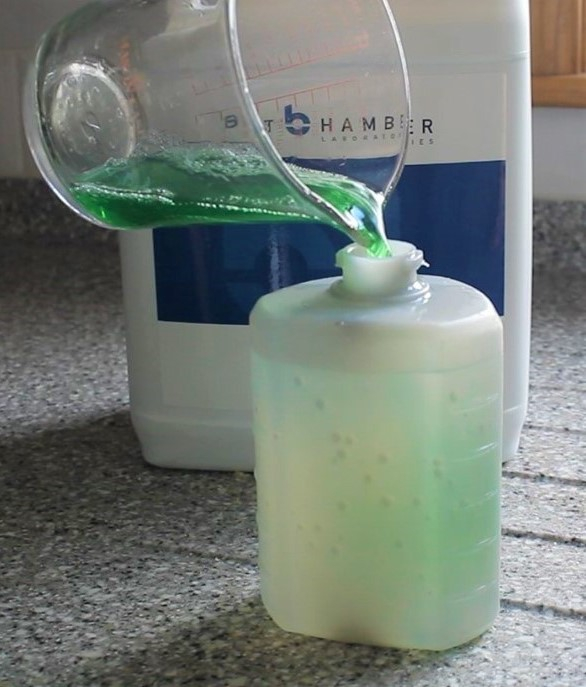
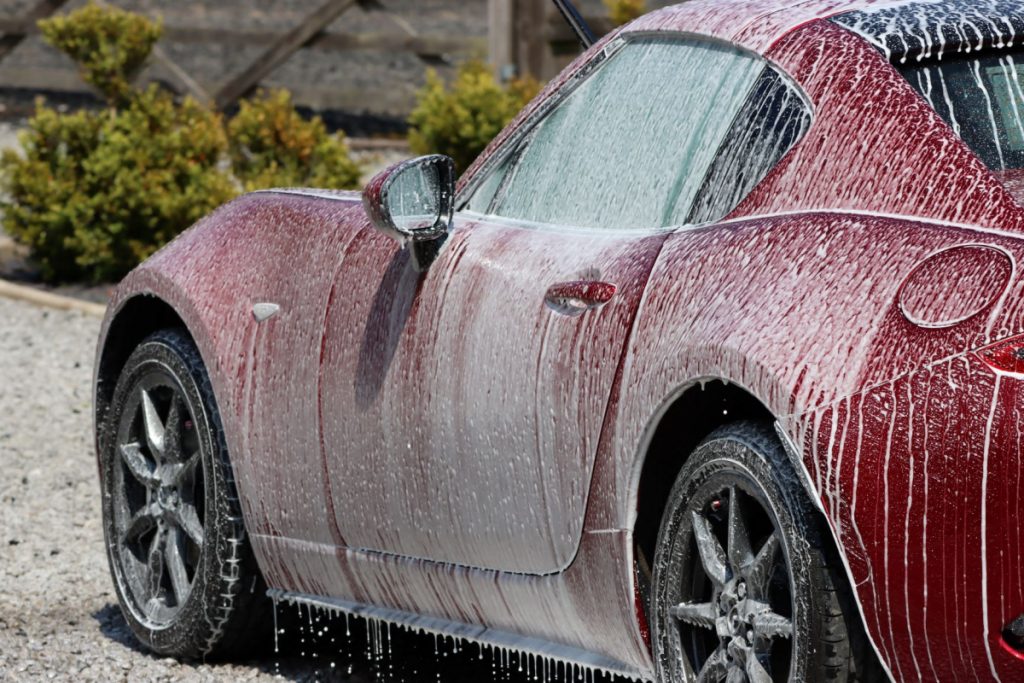
Snow Foam Alternatives
So what if you don’t have a snow foam and you still want to pre-wash your car to remove as much grime as possible before contact washing to minimise the risk of scratches?
You have a couple of options here.
- Traffic film removers
- Use car shampoo instead
- Citrus pre-wash sprays
Now let’s take a look at them in a bit more detail.
Traffic Film Removers vs Snow Foam
Traffic film removers (TFRs) are strong alkaline cleaners that have more cleaning power than snow foams, but are more aggressive. Hence, they can cause more damage to the paint if left to dry, and can promote corrosion and rusting because they are caustic chemicals.
TFRs can be used to strip waxes and sealants because they are alkaline, but should be used sparingly to protect the paintwork.
Take a look at this in-depth comparison of snow foams vs TFRs for some more detail.
Car Shampoo vs Snow Foam
Car shampoo and snow foam are both designed to clean and lift dirt and grime from a car’s exterior. However, they are formulated differently. Snow foams do not contain lubricants like car shampoos, so when rubbed into the paint with a wash mitt, increases the risk of scratches.
Snow foams are designed to dissolve dirt and grime so it can be rinsed away more easily, or softened so it can be remove using a wash mitt during the contact wash. Car shampoos are designed to clean and lubricate the paintwork to help the wash mitt glide over the paint more easily and reduce the risk of scratches.
You can use a car shampoo in a snow foam cannon, but it will be difficult to get the right level of foam thickness, and cleaning power as they are not formulated for use as a pre-wash.
Using snow foam in place of a car shampoo is more dangerous because snow foams do not adequately lubricate the paintwork like shampoos do, hence increase the risk of inflicting clear coat scratches and swirls.
Citrus Pre-Wash vs Snow Foam
Citrus pre-wash products often come in spray formats, or are used through a pressure washer in a cannon. They are alkaline chemicals which dissolve road grime and dirt so it can be rinsed away easily making the contact wash safer and less likely to cause scratches.
Citrus pre-wash products and snow foams both intend to remove as much dirt and grime as possible before the contact wash to minimise the risk of inflicting clear coat damage. However, citrus products are more alkaline so often have higher cleaning power, but more potential to strip waxes and sealants.
If you’re dealing with a particularly dirty car, it can be useful to pre-wash the lower panels (the dirtiest areas) using a citrus pre-wash, rinse, then snow foam the entire car. This helps to tackle the road grime, but without risking stripping the wax on the cleaner areas of the car.
Frequently Asked Questions
Here are some of the most frequently asked questions about snow foaming your car to get the best results.
How to use a Karcher Snow Foam cannon?
Karcher snow foam cannons are simple to use and only have one control to adjust the thickness of the foam. Here’s a quick video on the Auto Care HQ YouTube channel to demonstrate how to use a Karcher foam cannon.
Can I use snow foam on a soft top convertible?
Most snow foams are safe to use on soft top convertible roofs as long as they are not left to dry. Caution should be taken with alkaline snow foams as they can potentially cause staining if left to dwell for too long.
Can I use snow foam on a ceramic coating?
Snow foam is safe to use on a ceramic coating. It will help to remove as much dirt and grime as possible from the vehicle before using a wash mitt and minimise the chance of inflicting scratches during the wash process.
Can I use snow foam on a vinyl wrapped car?
Snow foam is safe to use on vinyl wrapped cars as long as it is not left to dry or dwell on the car for longer than specified by the manufacturer. Snow foam helps to remove traffic film from the car before contact washing with a mitt to prevent scratches during the wash process.
Thanks for reading! I hope you’ve enjoyed this article. Check out the rest of the website to learn everything you need to about car detailing.

